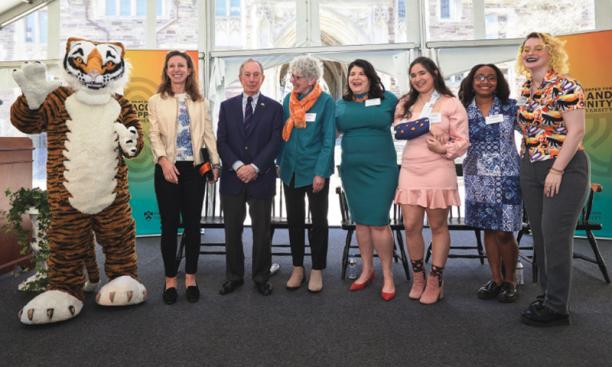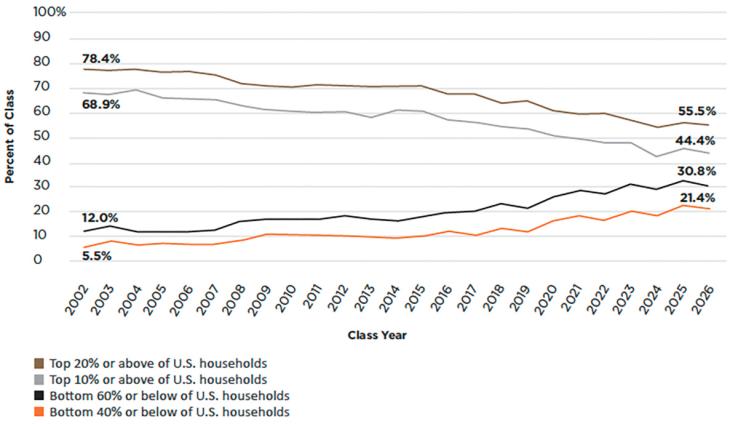
The most prominent U.S. college rankings have recently made changes to give more weight to educational outcomes and to diversity, and less credit to markers of prestige and affluence.
While I remain a strong critic of rankings as a precise decision tool for students and families, these methodological shifts are a welcome development, and one that Princeton has argued for. They may broaden the national conversation away from a fixation on selectivity and increase public literacy about important factors like graduation rates, economic outcomes, and access for students from less privileged backgrounds.
Followers of the various ranking schemes will note that Princeton’s rank has not changed on the most widely cited lists, even as the calculations that underlie the rankings have. Indeed, our position is stable even when metrics that favor Princeton, such as alumni-giving rates, are eliminated (as U.S. News & World Report did this year). We do equally well on rankings that prioritize the cultivation of leaders (Forbes), the economic value-add of a particular college (Wall Street Journal), and overall quality (U.S. News).
One reason for this consistency is that Princeton has for many years assiduously focused on what the rankings are just now prioritizing: excellence and access. Harvard economist Raj Chetty, whose landmark studies on inequality in higher education have generated much of the pressure on the rankings, recently said this on PBS NewsHour: “Princeton, in particular, has been a leader in admitting and recruiting more kids from lower-income families.”
I hope our experience can offer some practical insights on ways more schools can bend the socioeconomic curve in college admissions.
The chart here depicts the percentage of Princeton first-year students at the bottom and top of the U.S. income distribution over the last 25 years. The lines have been steadily converging, most sharply in the last decade, which means we are enrolling more lower- and middle-income students and fewer very high-income students.

Today, more than one in five incoming Princeton undergraduates is eligible for a Pell Grant. Nearly as many are the first in their families ever to attend college. Students representing the top 10 percent of households by income, meanwhile, have dropped from 61 percent in 2011 to 44 percent today. In reflecting on how we have achievedthese trends, at least four successful strategies emerge:
First, we train our Admission team to recognize that persevering through socioeconomic disadvantage is a direct indicator of potential success in college and beyond. Holding down a job while standing out academically in high school counts for a lot at Princeton.
Second, we invest heavily in pre-college bridge programs that encourage talented low-income and first-generation students to apply to highly selective schools and support their successful transition to college, at Princeton and elsewhere.
Third, we offer incredible financial aid. Two-thirds of Princeton freshmen receive aid. Nearly a quarter of our student body pays nothing to attend. We know college can be very expensive even for upper middle-class families, so our aid extends to families making up to and even beyond $300,000 a year, including those at higher income levels with more than one child in college.
Finally, as PAW readers well know, we are expanding our student body. Supreme Court Chief Justice John Roberts, in his disappointing opinion striking down affirmative action, said, “College admissions are zero sum.” Not so at Princeton, where we have added undergraduate seats to allow us to accept more talented students from all backgrounds. We have also expanded our transfer program, with a focus on community college students and active military and veterans.
While I am proud of Princeton’s achievements on socioeconomic diversity, you will not see a “mission accomplished” sign on this chart. We have work to do, particularly as it relates to the representation of students from middle-class families. The middle class will be an area of special focus for our Admission team in the coming years.
You will also not see Princeton advertising our latest ranking—but neither do we withhold information from rankings outlets, as some schools have done. These journalistic exercises, even if flawed, can contribute to public appreciation of the value of higher education, which is desperately needed.
Princeton alumni can help by spreading the word about the progress we’ve made, which is also not as widely known as we’d like. I hope it fills you with pride that Princeton is more excellent and more diverse (these are mutually reinforcing qualities) than ever in its history, and that you’ll help us tell that story.
It must be acknowledged that the strategies outlined above are labor- and time-intensive and require an all- hands-on-deck mentality from hundreds of people over many years. They are also expensive and made possible by Princeton’s endowment, which exists thanks to the strong bonds we enjoy with our alumni.
Those bonds may no longer figure into the rankings, but all of us at Old Nassau know they remain the secret sauce to Princeton’s success, and we value them today more than ever.
